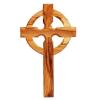I need to further elaborate on my earlier response as I did not have time to post a proper response.
e-Sword is available for both Windows PC's and several Apple/Mac devices including iPad, iPhone, and Mac Computers. The two different variations of e-Sword have used different module formats since both versions became available. The Windows PC version originally used rtf based modules exclusively while the Apple/Mac version use html based modules.
The Windows and Apple/Mac versions each have there own module file types:
Windows file formats
Bible (bblx)
Commentary (cmtx)
Dictionary (dctx)
Bible Reading Plan (brpx)
Devotional (devx)
Topic (topx)
Harmony File (harx)
Maps/Graphics (mapx)
Apple/Mac file formats:
Bible (bbli)
Commentary (cmti)
Dictionary (dcti)
Bible Reading Plan (brpi).
Devotional (devi)
Reference Library (refi)
Topic File (topi)
Neither version of e-Sword could run both module formats until e-Sword 11 was released for Windows PC's in 2016. When e-Sword 11 was released it been given an overhaul so that it could now use both rtf and html module formats. This change allowed modules that were originally created exclusively for Apple/Mac use to be used with e-Sword on Windows. As well as new html based modules to be created for use on e-Sword for Windows
e-Sword Tooltip NT has always had the capability to create modules for both Windows and Apple/Mac versions of e_Sword. Until the last version of e-Sword Tooltip was released there were two menu options on the menu across the top of Tooltip labeled "Modules" and "Modules HD".
The option labeled "Modules" accessed a drop down menu with a number of options needed to create modules for the Windows version of e-Sword.
The option labeled "Modules HD" accessed a drop menu with the options needed to create modules in html format for use with Apple/Mac devices and now both e-Sword 11 and e-sword 12 for windows.
The most recent update to Tooltip NT which was released back in April included a change where the "Modules" menu option was relabeled "Modules 3" and the "Modules HD" was relabeled "Modules 4". Both options still access the same drop menu as before the change in name was done to better reflect the information that is found in the headers of all modules.
Here is the header information for an rtf based bible module:
#define description=DESC
#define abbreviation=ABBR
#define comments=CMTS
#define version=3
#define strong=0
#define right2left=0
#define ot=0
#define nt=1
#define font=DEFAULT
#define apocrypha=0
Note the line that reads #define version=3" this information determines that bible module will be used on Windows PC's
Now here is the header information for html based bible module:
#define title=TITLE
#define abbreviation=ABBR
#define information=Enter Info Here
#define versionHD=4
#define ot=1
#define nt=1
#define apocrypha=0
#define strong=0
#define right2left=0
Most of the information the same except for the line that reads #define versionHD=4
This determines the bible module is an html module that will work with e-Sword for the Apple/Mac and both e-Sword 11 & 12 for windows.
To fix the issue you asked about, first make sure you are using either e-Sword 11 or 12 for Windows.
You can open the module in question in Tooltip, provided it is not a licensed module, and make the changes to the module header then save the module in the html format. You can also do any editing you might want to do with Tooltip.
If Tooltip is not comfortable there is a module converter available that can convert the modules from Windows to Apple/MAC or html format available at this link:
https://www.e-sword.net/extras.html

















